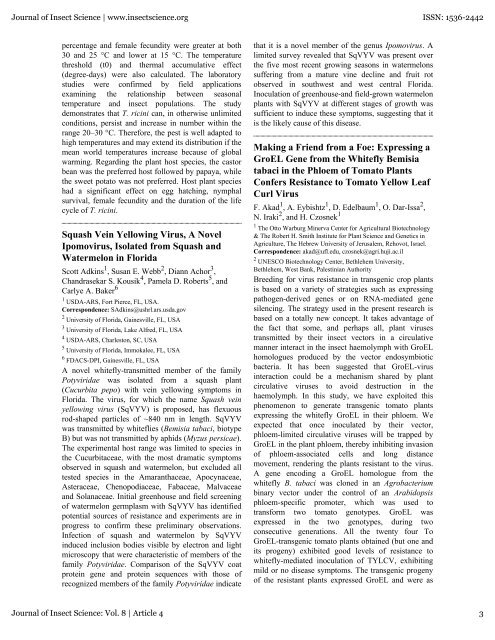Fourth International Bemisia Workshop International Whitefly ...
Fourth International Bemisia Workshop International Whitefly ...
Fourth International Bemisia Workshop International Whitefly ...
Create successful ePaper yourself
Turn your PDF publications into a flip-book with our unique Google optimized e-Paper software.
Journal of Insect Science | www.insectscience.org ISSN: 1536-2442<br />
percentage and female fecundity were greater at both<br />
30 and 25 °C and lower at 15 °C. The temperature<br />
threshold (t0) and thermal accumulative effect<br />
(degree-days) were also calculated. The laboratory<br />
studies were confirmed by field applications<br />
examining the relationship between seasonal<br />
temperature and insect populations. The study<br />
demonstrates that T. ricini can, in otherwise unlimited<br />
conditions, persist and increase in number within the<br />
range 20–30 °C. Therefore, the pest is well adapted to<br />
high temperatures and may extend its distribution if the<br />
mean world temperatures increase because of global<br />
warming. Regarding the plant host species, the castor<br />
bean was the preferred host followed by papaya, while<br />
the sweet potato was not preferred. Host plant species<br />
had a significant effect on egg hatching, nymphal<br />
survival, female fecundity and the duration of the life<br />
cycle of T. ricini.<br />
Squash Vein Yellowing Virus, A Novel<br />
Ipomovirus, Isolated from Squash and<br />
Watermelon in Florida<br />
Scott Adkins 1 , Susan E. Webb 2 , Diann Achor 3 ,<br />
Chandrasekar S. Kousik 4 , Pamela D. Roberts 5 , and<br />
Carlye A. Baker 6<br />
1 USDA-ARS, Fort Pierce, FL, USA.<br />
Correspondence: SAdkins@ushrl.ars.usda.gov<br />
2 University of Florida, Gainesville, FL, USA<br />
3 University of Florida, Lake Alfred, FL, USA<br />
4 USDA-ARS, Charleston, SC, USA<br />
5 University of Florida, Immokalee, FL, USA<br />
6 FDACS-DPI, Gainesville, FL, USA<br />
A novel whitefly-transmitted member of the family<br />
Potyviridae was isolated from a squash plant<br />
(Cucurbita pepo) with vein yellowing symptoms in<br />
Florida. The virus, for which the name Squash vein<br />
yellowing virus (SqVYV) is proposed, has flexuous<br />
rod-shaped particles of ~840 nm in length. SqVYV<br />
was transmitted by whiteflies (<strong>Bemisia</strong> tabaci, biotype<br />
B) but was not transmitted by aphids (Myzus persicae).<br />
The experimental host range was limited to species in<br />
the Cucurbitaceae, with the most dramatic symptoms<br />
observed in squash and watermelon, but excluded all<br />
tested species in the Amaranthaceae, Apocynaceae,<br />
Asteraceae, Chenopodiaceae, Fabaceae, Malvaceae<br />
and Solanaceae. Initial greenhouse and field screening<br />
of watermelon germplasm with SqVYV has identified<br />
potential sources of resistance and experiments are in<br />
progress to confirm these preliminary observations.<br />
Infection of squash and watermelon by SqVYV<br />
induced inclusion bodies visible by electron and light<br />
microscopy that were characteristic of members of the<br />
family Potyviridae. Comparison of the SqVYV coat<br />
protein gene and protein sequences with those of<br />
recognized members of the family Potyviridae indicate<br />
that it is a novel member of the genus Ipomovirus. A<br />
limited survey revealed that SqVYV was present over<br />
the five most recent growing seasons in watermelons<br />
suffering from a mature vine decline and fruit rot<br />
observed in southwest and west central Florida.<br />
Inoculation of greenhouse-and field-grown watermelon<br />
plants with SqVYV at different stages of growth was<br />
sufficient to induce these symptoms, suggesting that it<br />
is the likely cause of this disease.<br />
Making a Friend from a Foe: Expressing a<br />
GroEL Gene from the <strong>Whitefly</strong> <strong>Bemisia</strong><br />
tabaci in the Phloem of Tomato Plants<br />
Confers Resistance to Tomato Yellow Leaf<br />
Curl Virus<br />
F. Akad 1 , A. Eybishtz 1 , D. Edelbaum 1 , O. Dar-Issa 2 ,<br />
N. Iraki 2 , and H. Czosnek 1<br />
1 The Otto Warburg Minerva Center for Agricultural Biotechnology<br />
& The Robert H. Smith Institute for Plant Science and Genetics in<br />
Agriculture, The Hebrew University of Jerusalem, Rehovot, Israel.<br />
Correspondence: akad@ufl.edu, czosnek@agri.huji.ac.il<br />
2 UNESCO Biotechnology Center, Bethlehem University,<br />
Bethlehem, West Bank, Palestinian Authority<br />
Breeding for virus resistance in transgenic crop plants<br />
is based on a variety of strategies such as expressing<br />
pathogen-derived genes or on RNA-mediated gene<br />
silencing. The strategy used in the present research is<br />
based on a totally new concept. It takes advantage of<br />
the fact that some, and perhaps all, plant viruses<br />
transmitted by their insect vectors in a circulative<br />
manner interact in the insect haemolymph with GroEL<br />
homologues produced by the vector endosymbiotic<br />
bacteria. It has been suggested that GroEL-virus<br />
interaction could be a mechanism shared by plant<br />
circulative viruses to avoid destruction in the<br />
haemolymph. In this study, we have exploited this<br />
phenomenon to generate transgenic tomato plants<br />
expressing the whitefly GroEL in their phloem. We<br />
expected that once inoculated by their vector,<br />
phloem-limited circulative viruses will be trapped by<br />
GroEL in the plant phloem, thereby inhibiting invasion<br />
of phloem-associated cells and long distance<br />
movement, rendering the plants resistant to the virus.<br />
A gene encoding a GroEL homologue from the<br />
whitefly B. tabaci was cloned in an Agrobacterium<br />
binary vector under the control of an Arabidopsis<br />
phloem-specific promoter, which was used to<br />
transform two tomato genotypes. GroEL was<br />
expressed in the two genotypes, during two<br />
consecutive generations. All the twenty four To<br />
GroEL-transgenic tomato plants obtained (but one and<br />
its progeny) exhibited good levels of resistance to<br />
whitefly-mediated inoculation of TYLCV, exhibiting<br />
mild or no disease symptoms. The transgenic progeny<br />
of the resistant plants expressed GroEL and were as<br />
Journal of Insect Science: Vol. 8 | Article 4 3
















